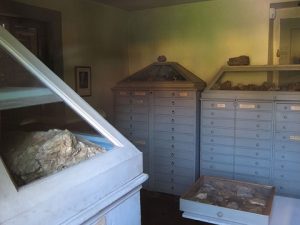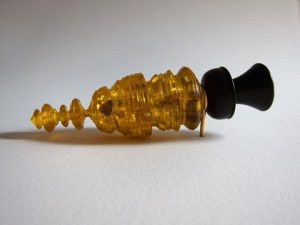Dec 2020
III. Kulturgeschichtliche Analysen: Getting into the Groove: Jurassic Antecedents to Goethe’s and Rilke’s Thoughts on Music
Getting into the Groove:
Jurassic Antecedents to Goethe’s and
Rilke’s Thoughts on Music
Peter Eudenbach, Norfolk, Virginia

Goethe’s rock collection in Weimar. Photo by the author |
“Die Baukunst ist eine erstarrte Musik.”
Architecture is frozen music.
Johann Wolfgang von Goethe, 1829
Goethe’s comment offers a parallel between the spatial and the temporal, proposing that inanimate structures are capable of movement, rhythm, and harmony. His choice of the word erstarrte (a hybrid between frozen and fossilized) suggests a solidified music that may become liquid again. As a collector of rocks and fossils, the poet would have certainly been intrigued by Jurassic Serenade, a project I created in 2016 inspired by a fossil discovered almost 200 years after Goethe’s observation.
The sound of one wing stridulating
Jurassic Serenade is a sound sculpture inspired by what may be the oldest recorded sound on earth. In 2012, a team of scientists discovered a fossilized cricket wing in Northwestern China. This detailed specimen (called A. musicus) enabled researchers to reconstruct the cricket’s song from the meticulously preserved stridulations in the insect’s wings. A mating call from the Jurassic era, a cry into the darkness from 165 million years ago was resurrected from its suspended state.[1] This serenade or fragment of Nachtmusik was not permanently fossilized but serendipitously frozen and electronically thawed after millions of years.
“Beneath an autumn moon
The cricket’s final song
Echoes into eternity”[2]
It is especially remarkable that this fossilized cricket was found in China. The specimen dates to a time before Chinese culture and long before there were even any Chinese people. For centuries however, the Chinese have lovingly kept crickets for their songs, almost as a form of auditory incense. Crickets were also associated with death and resurrection, since they disappear in the autumn and return in the spring. Elaborately decorated cricket cages were commissioned by nobility and became a highly evolved art form in China.
|
Jurassic Serenade, 2016, carved amber, ebony, sound component, dimensions variable. A collaborative project by Peter Eudenbach and Alfredo Marin. |
As shown in the video, the turned amber “vessel” is based on the pulse envelope of the reconstructed cricket song. Well known for preserving insects, amber (Bernstein) is fossilized tree sap. As a liquid made solid, it was an obvious material for a sculpture based on ancient music trapped in stone. Attached to the amber is an ebony horn modeled on the mouthpiece of an early telephone. From inside the mouthpiece, a small speaker emits an original composition by sound artist Alfredo Marin based on this echo from the distant past, a sound no human being had ever heard until only a few years ago.
From Umlaut to Urgeräusch
Rainer Maria Rilke’s famous essay “Primal Sound” from 1919, arguably prefigures the Jurassic song resurrected from the fossilized grooves of a cricket wing. The stridulations in the wing coincide with Rilke’s fixation on unintentional recordings. In this short essay, the poet speculates on what kind of sound or meaning might be found if a phonograph needle were to pass over the coronal suture lines of a human skull.
“What if one changed the needle and directed it on its return journey along a tracing which was not derived from the graphic translation of sound, but existed of itself naturally-well, to put it plainly, along the coronal suture, for example”.[3]
Despite Rilke’s poetic desire to draw meaning from otherwise serendipitous patterns, can coronal suture lines on a skull actually say something like a coded message or have potential to emit any meaningful sounds? (as if Thomas Edison had been a phrenologist) It is quite a leap to suggest the suture lines signify anything at all. The Swedish writer Karl Erik-Tallmo describes Rilke’s experiment as an attempt to read something not actually written. The important difference between Rilke’s cranial tectonic plates and Jurassic Serenade is that the fossilized cricket wing actually has content to be decoded, permitting a dialog between poetry and science. From this perspective, the poet’s thought experiment is more about the nature of coding and how meaning is not lost in translation but ultimately created by it. “All intelligent thoughts have already been thought”; Goethe tells us, “what is necessary is only to try to think them again.”[4]
Footnotes:
[1] With many thanks to Dr. Fernando Montealegre‐Zapata who analyzed the fossil to reconstruct the song of the Jurassic bush cricket (Archaboilus musicus) and to Sergey Jivetin and Alfredo Marin for their contributions to this project.
[2] Anonymous fragment from the T’ang Dynasty. Witter, Bynner. The Jade Mountain: A Chinese Anthology, Being Three Hundred Poems of the T’ang Dynasty, 618-906. New York: A.A. Knopf, 1929.
[3] Rilke, Rainer Maria. Primal Sounds and other Prose Pieces. Cummington, MA: Cummington Press, 1943, cited above from http://layoftheland.net/archive/art4639-2013/weeks1-5/RILKE_SOUND.pdf.
[4] Goethe, Johann Wolfgang von. Maxims and Reflections, Maxim 441. London: Penguin Books Limited, 1998, translated by Elizabeth Stopp.

